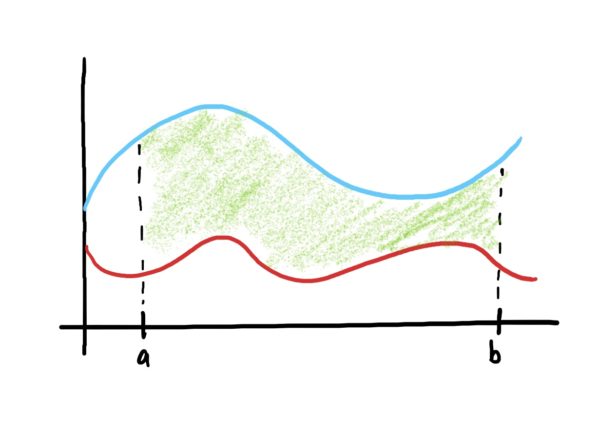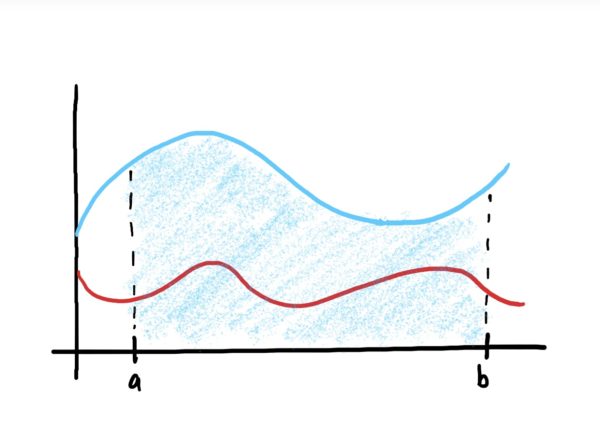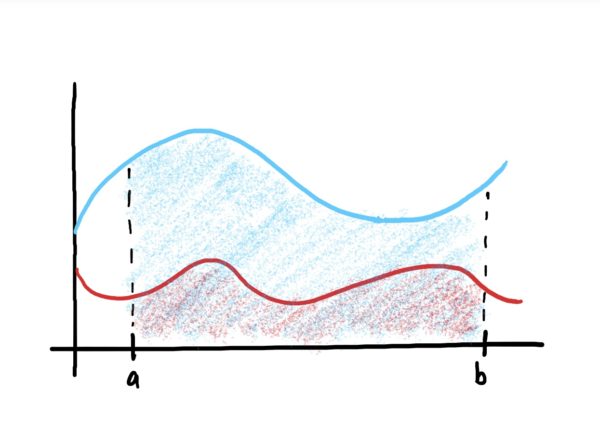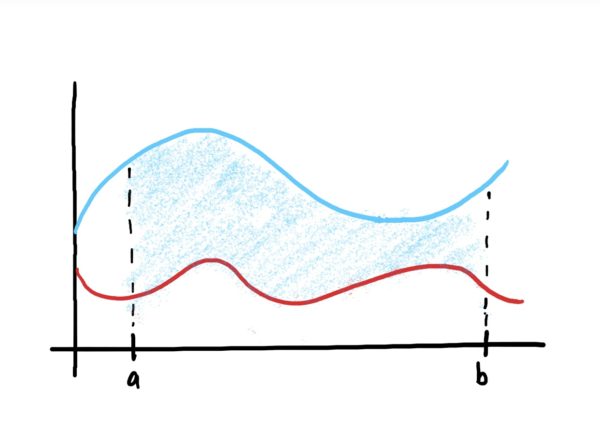Areas Between Curves
Finding Areas Between Curves
We at times are interested in determining the area between two curves defined on an interval. This is depicted below. This sort of situation arises when one wants to find differences between totals of quantities that continuously vary.

Thankfully, finding the area between two curves is easy!
If you look at the second formula above, the first integral gives you the area under the top function \(f\), and the second gives you the area under \(g\). We are subtracting the integrals because in order to find the area between the two curves, we are effectively subtracting the area of \(g\) away from the area under \(f\) (because the area under \(g\) is contained in the area under \(f\)). This idea is depicted in the image sequence below.



Note that the first formula is nothing more than a combination of the two integrals into a single integral using the additive property for antiderivatives/integrals.
Determining the Top Function
More often than not, we are not given the graphs of the two functions whose graphs we want to find the area between. As such, in order to use the formula above, we need to determine which function is the “top” function. This is easy, assuming that your functions don’t cross: Simply take your favorite \(x\)-value on the given interval and plug it into both functions. Whichever one produces the higher \(y\)-value is the top function (because we are assuming the graphs don’t cross at all, which would change which function is “on top.”) Try some of the examples below, seeing if you can solve a few of them without anything but the formula above and the method for determining the “top” function just described.
Subtract the lower function from the higher, then integrate the result.
Area between \(f\) and \(g\) on \([a,b]\) = \(\int^b_a f(x)-g(x)\ dx\) where the top function is \(f\), in this case.
Computing areas between two curves on an interval:
- Given functions \(f,g\), determine which function is the “top” function. Either:
- Graph the two functions and pick the top
- plug an \(x\)-value between \(a\) and \(b\) into both functions. Whichever has a bigger \(y\)-value is the top function. (NOTE: we are running under the assumption that the graphs don’t cross on \([a,b]\))
- Subtract the bottom function from the top; maybe simplify.
- Integrate
Area\(=\frac{8}{3}\)
Subtract the lower function from the higher, then integrate the result.
Area between \(f\) and \(g\) on \([a,b]\) = \(\int^b_a f(x)-g(x)\ dx\) where the top function is \(f\), in this case.
Computing areas between two curves on an interval:
- Given functions \(f,g\), determine which function is the “top” function. Either:
- Graph the two functions and pick the top
- plug an \(x\)-value between \(a\) and \(b\) into both functions. Whichever has a bigger \(y\)-value is the top function. (NOTE: we are running under the assumption that the graphs don’t cross on \([a,b]\))
- Subtract the bottom function from the top; maybe simplify.
- Integrate
Area\(=6\)
Subtract the lower function from the higher, then integrate the result.
Area between \(f\) and \(g\) on \([a,b]\) = \(\int^b_a f(x)-g(x)\ dx\) where the top function is \(f\), in this case.
Computing areas between two curves on an interval:
- Given functions \(f,g\), determine which function is the “top” function. Either:
- Graph the two functions and pick the top
- plug an \(x\)-value between \(a\) and \(b\) into both functions. Whichever has a bigger \(y\)-value is the top function. (NOTE: we are running under the assumption that the graphs don’t cross on \([a,b]\))
- Subtract the bottom function from the top; maybe simplify.
- Integrate
Area\(=\frac{1}{4}\)
Subtract the lower function from the higher, then integrate the result.
Area between \(f\) and \(g\) on \([a,b]\) = \(\int^b_a f(x)-g(x)\ dx\) where the top function is \(f\), in this case.
Computing areas between two curves on an interval:
- Given functions \(f,g\), determine which function is the “top” function. Either:
- Graph the two functions and pick the top
- plug an \(x\)-value between \(a\) and \(b\) into both functions. Whichever has a bigger \(y\)-value is the top function. (NOTE: we are running under the assumption that the graphs don’t cross on \([a,b]\))
- Subtract the bottom function from the top; maybe simplify.
- Integrate
Area\(=\frac{5}{8}-\ln\left \vert \frac{1}{2} \right\vert \)
Subtract the lower function from the higher, then integrate the result.
Area between \(f\) and \(g\) on \([a,b]\) = \(\int^b_a f(x)-g(x)\ dx\) where the top function is \(f\), in this case.
Computing areas between two curves on an interval:
- Given functions \(f,g\), determine which function is the “top” function. Either:
- Graph the two functions and pick the top
- plug an \(x\)-value between \(a\) and \(b\) into both functions. Whichever has a bigger \(y\)-value is the top function. (NOTE: we are running under the assumption that the graphs don’t cross on \([a,b]\))
- Subtract the bottom function from the top; maybe simplify.
- Integrate
Area\(=\frac{4}{3}\)
Subtract the lower function from the higher, then integrate the result.
Area between \(f\) and \(g\) on \([a,b]\) = \(\int^b_a f(x)-g(x)\ dx\) where the top function is \(f\), in this case.
Computing areas between two curves on an interval:
- Given functions \(f,g\), determine which function is the “top” function. Either:
- Graph the two functions and pick the top
- plug an \(x\)-value between \(a\) and \(b\) into both functions. Whichever has a bigger \(y\)-value is the top function. (NOTE: we are running under the assumption that the graphs don’t cross on \([a,b]\))
- Subtract the bottom function from the top; maybe simplify.
- Integrate
Area\(=\frac{1}[6}\)
Subtract the lower function from the higher, then integrate the result.
Area between \(f\) and \(g\) on \([a,b]\) = \(\int^b_a f(x)-g(x)\ dx\) where the top function is \(f\), in this case.
Computing areas between two curves on an interval:
- Given functions \(f,g\), determine which function is the “top” function. Either:
- Graph the two functions and pick the top
- plug an \(x\)-value between \(a\) and \(b\) into both functions. Whichever has a bigger \(y\)-value is the top function. (NOTE: we are running under the assumption that the graphs don’t cross on \([a,b]\))
- Subtract the bottom function from the top; maybe simplify.
- Integrate
Area\(=\frac{8}{3}\)
Subtract the lower function from the higher, then integrate the result.
Area between \(f\) and \(g\) on \([a,b]\) = \(\int^b_a f(x)-g(x)\ dx\) where the top function is \(f\), in this case.
Computing areas between two curves on an interval:
- Given functions \(f,g\), determine which function is the “top” function. Either:
- Graph the two functions and pick the top
- plug an \(x\)-value between \(a\) and \(b\) into both functions. Whichever has a bigger \(y\)-value is the top function. (NOTE: we are running under the assumption that the graphs don’t cross on \([a,b]\))
- Subtract the bottom function from the top; maybe simplify.
- Integrate
Area\(=8\)
